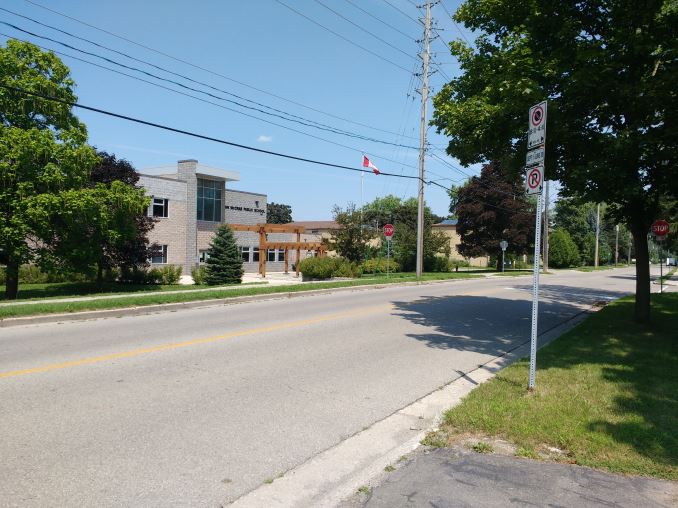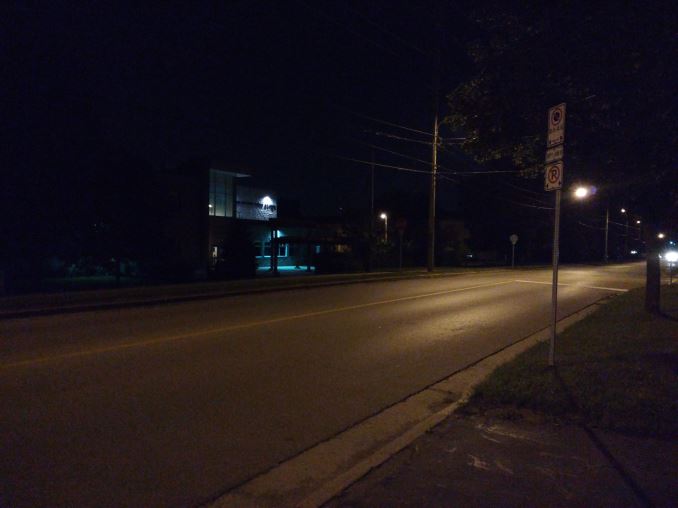The Moto G (2015) Review
by Brandon Chester on August 19, 2015 8:00 AM EST- Posted in
- Smartphones
- Mobile
Camera
One of the most notable improvements to the 2015 Moto G is its new rear-facing camera. The 2014 Moto G used Sony's IMX179, while the 2015 model adopts IMX214. The sensor size increases from 1/3.2" to 1/3.06" and the resolution increases from 8MP to 13MP. The aperture is also much wider, moving from F/2.4 to F/2.0, which can help offset the lower sensitivity of the smaller pixels. An overview of the Moto G's cameras can be found in the chart below.
| Camera Specifications | |||
| Moto G (2015) | |||
| Front Camera | 5MP (2560x1920) |
||
| Front Camera - Sensor | S5K5E2 (1.12 µm, 1/5") |
||
| Front Camera - Max Aperture | F/2.2 | ||
| Rear Camera | 13.0MP (4224x3400) |
||
| Rear Camera - Sensor | Sony IMX214 (1.12 µm, 1/3.06") |
||
| Rear Camera - Focal Length | 3.6mm (26mm eff) | ||
| Rear Camera - Max Aperture | F/2.0 | ||
While the Moto G lacks the voice coil motor from the Nexus 6 which is needed to enable OIS, the rest of the camera stack is effectively identical. The one difference on paper is the Moto G's shorter focal length which will give images a wider field of view.
Coincidentally, the move from IMX179 to IMX214 is the exact same change made between the Nexus 5 and Nexus 6. Whatever differences there are between the image quality of the 2015 Moto G and the Nexus 6 in good lighting rests primarily in the hands of their image signal processors. The Nexus 6 will obviously have a low light advantage due to its inclusion of OIS to lengthen shutter times, and we'll get to the low light differences after covering image quality with generous lighting.

In this daylight scene the Moto G performs very well. The exposure is very good, although I feel that it underexposed slightly while the Nexus 6 overexposed slightly. The Nexus 6 definitely has an edge when it comes to the sharpness of grass and foliage, as well as the preservation of textures such as the walls of the building and the pavement of the road. It's also worth noting that there's some lens distortion occurring on the Moto G which is causing color fringing along the white edges of the building windows, although at a normal viewing size it's barely noticeable. I think the Nexus 6 took an overall better photo, but only slightly better, with the Moto G doing a better job than any other mid-range device I've tested during the day.

Low light image quality is where things start to fall apart on the Moto G. While it's difficult to see in the small preview above, looking at the full size image reveals a great deal of color noise throughout the entire image, which doesn't exist on the Nexus 6. The Moto G took a 1/15s exposure, while the Nexus 6 was longer at 1/12s. 1/12s actually isn't very long for a device with OIS, and the difference in ISO value was not very large between the two devices either which means that Motorola's lacking quality has more to do with a simple lack of chroma noise reduction more than anything else. Chroma noise is by far the most distracting type of artifact in photos, and unfortunately it makes the Moto G unsuitable for photography in low light.
Video Quality
Video recording is a great test of a device's ISP as there's only a very short timespan to do processing on each frame that is captured. Since the 2015 Moto G and the Nexus 6 use the same image sensor this allows us to take a look at the differences in video quality between the ISPs in Snapdragon 410 and Snapdragon 805.
The Moto G records 1080p video at 30fps. Video is encoded with an average bitrate of 17Mbps using the H.264 high profile. For this comparison I limited the Nexus 6 to 1080p rather than UHD recording to make it an apples to apples comparison.
The most obvious advantage the Nexus 6 has is the stability of the video. While one might think this is due to the inclusion of OIS, the Nexus 6 isn't using the OIS for stabilization, and this is really just a case of superior EIS enabled by the superior ISP. As for the video quality itself, it's clear that the Nexus 6 is sharper across the frame and has greater detail on the various types of foliage in the area. The Nexus 6 also manages a better exposure, with the Moto G's video being too dark, with muted and just generally inaccurate colors. It appears that like the low light photo scene, the Moto G's video recording abilities are hampered by its ISP.
WiFi Performance
Like almost all of the low end and mid range devices I've tested recently, the Moto G ships with support for 802.11n on the 2.4GHz band. This single spatial stream implementation has a max link speed of 72Mbps.

The Moto G's WiFi speed is roughly the same as all other mid range devices. The Zenfone 2 is once again an exception to the rule, but I don't think anyone buying a device like the Moto G will have adopted an 802.11ac router at this point anyway due to cost reasons. I really hope we start seeing 5GHz support in mid range 802.11n phones though, rather than the ever increasingly crowded 2.4GHz band.






















90 Comments
View All Comments
kmmatney - Wednesday, August 19, 2015 - link
They are in the $115 - $130 range on Swappa (at least the Sprint version). Of course that is used - but the phones I've bought from Swappa all looked brand-new when I received them. You can also get a used Galaxy S4 for ~$130, and will come with 2 GB of RAM and 16GB of storgae, and will be faster.Moto1 - Wednesday, August 19, 2015 - link
Nope, sorryamdwilliam1985 - Thursday, August 20, 2015 - link
Moto G 2015 will probably beat Galaxy S6 and Note 5 in general phone usage speed test, lol. So Galaxy S4 is probably not a good comparison to.3DoubleD - Wednesday, August 19, 2015 - link
It is not clear in the charging section whether the Moto G is limited to 2.75 W charging internally, or whether it is because a 2.75 W charger was used (because it was shipped with one). Could one conceivably use a 5 W or 10 W charger and cut the charge time in half or a quarter? This is not clear. I honestly didn't know they made 2.75 W chargers, the smallest charger I've ever seen is 1 A @ 5 V.Also, how crippling is this GPU performance? From what I can tell, an Adreno 305 is about 1/4 of the speed of the Nexus 5 (2013) in offscreen testing with Basemark X. But this doesn't describe the context of what it is like to use an Adreno 306 device. Does the UI studder? Does video playback work flawlessly? Does it play most games? Are there any notable games it does not play?
Also, I take issue with the comment that waterproofing is not a desirable feature because you can't use the display while wet. That is an insane comment to make! Most people would like some piece of mind that if their phone gets a little wet it won't become an expensive paper weight. That is a huge feature, especially considering the target market for this phone - a group that may likely be careless with their phone that it needs to be inexpensive and waterproof. So I'll say this in the comments since it wasn't said in the review: Motorola, good job making this phone waterproof.
Lastly, I don't think Motorola was praised enough for adding a bigger battery at the cost of not decreasing the thinness of the device. Phone manufacturers frequently shift the balance the wrong way, and finally Motorola stepped up and did it right.
Despite all of my question and critiques, I really appreciate the timely review! Thanks!
hans_ober - Wednesday, August 19, 2015 - link
Yeah, nice to see Moto worked on the battery and didn't go for 'omg 7mm slim' type of device.Thick phone > dead slim paperweight.
Brandon Chester - Wednesday, August 19, 2015 - link
1. It's just that the phone is shipped with a 2.75W charger. I will be listing a charge time using a 5W charging block, but to my knowledge there's no quick charge support so there's no additional advantage to using an even higher wattage QC 2.0 block2. You can play 2D games and very simple 3D ones like temple run, but there's not much hope for what one would call AAA mobile games. My big issue is the lack of GPU performance in mid range Android devices ends up limiting the availability and quality of those games on Android as a whole.
3. At no point did I ever say that waterproofing was not a desirable feature, or anything of that sort. I said it's nice to have, but I don't think it's a selling point. There's no evidence that any significant number of consumers are buying devices specifically because they're waterproof, so I don't think my observation was incorrect.
4. Not everyone shares the opinion that devices should get substantially larger to fit bigger batteries.
hans_ober - Wednesday, August 19, 2015 - link
Thanks. Yeah, theres no QC 2.0 support, but using 5W and even 10W chargers has reportedly cut short charging time. No harm in adding QC 2.0 to the graph too; it will show max possible charge rate, with the phone as bottleneck.Brandon Chester - Wednesday, August 19, 2015 - link
I'm just trying to kill the phone's battery now so I can charge it.hans_ober - Wednesday, August 19, 2015 - link
Having a bad time? :)hans_ober - Tuesday, August 25, 2015 - link
Update on charging time?